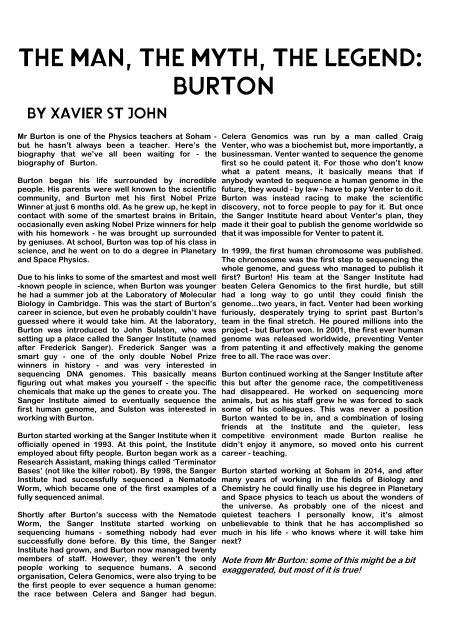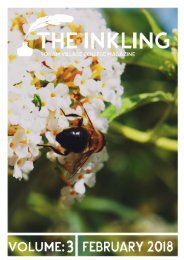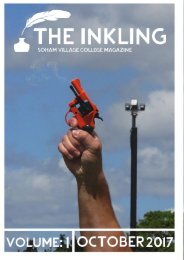The Inkling Volume 2
Create successful ePaper yourself
Turn your PDF publications into a flip-book with our unique Google optimized e-Paper software.
<strong>The</strong> Man, <strong>The</strong> Myth, <strong>The</strong> Legend:<br />
By Xavier St John<br />
Mr Burton is one of the Physics teachers at Soham -<br />
but he hasn’t always been a teacher. Here’s the<br />
biography that we’ve all been waiting for - the<br />
biography of Burton.<br />
Burton began his life surrounded by incredible<br />
people. His parents were well known to the scientific<br />
community, and Burton met his first Nobel Prize<br />
Winner at just 6 months old. As he grew up, he kept in<br />
contact with some of the smartest brains in Britain,<br />
occasionally even asking Nobel Prize winners for help<br />
with his homework - he was brought up surrounded<br />
by geniuses. At school, Burton was top of his class in<br />
science, and he went on to do a degree in Planetary<br />
and Space Physics.<br />
Due to his links to some of the smartest and most well<br />
-known people in science, when Burton was younger<br />
he had a summer job at the Laboratory of Molecular<br />
Biology in Cambridge. This was the start of Burton’s<br />
career in science, but even he probably couldn’t have<br />
guessed where it would take him. At the laboratory,<br />
Burton was introduced to John Sulston, who was<br />
setting up a place called the Sanger Institute (named<br />
after Frederick Sanger). Frederick Sanger was a<br />
smart guy - one of the only double Nobel Prize<br />
winners in history - and was very interested in<br />
sequencing DNA genomes. This basically means<br />
figuring out what makes you yourself - the specific<br />
chemicals that make up the genes to create you. <strong>The</strong><br />
Sanger Institute aimed to eventually sequence the<br />
first human genome, and Sulston was interested in<br />
working with Burton.<br />
Burton started working at the Sanger Institute when it<br />
officially opened in 1993. At this point, the Institute<br />
employed about fifty people. Burton began work as a<br />
Research Assistant, making things called ‘Terminator<br />
Bases’ (not like the killer robot). By 1998, the Sanger<br />
Institute had successfully sequenced a Nematode<br />
Worm, which became one of the first examples of a<br />
fully sequenced animal.<br />
Shortly after Burton’s success with the Nematode<br />
Worm, the Sanger Institute started working on<br />
sequencing humans - something nobody had ever<br />
successfully done before. By this time, the Sanger<br />
Institute had grown, and Burton now managed twenty<br />
members of staff. However, they weren’t the only<br />
people working to sequence humans. A second<br />
organisation, Celera Genomics, were also trying to be<br />
the first people to ever sequence a human genome:<br />
the race between Celera and Sanger had begun.<br />
Burton<br />
Celera Genomics was run by a man called Craig<br />
Venter, who was a biochemist but, more importantly, a<br />
businessman. Venter wanted to sequence the genome<br />
first so he could patent it. For those who don’t know<br />
what a patent means, it basically means that if<br />
anybody wanted to sequence a human genome in the<br />
future, they would - by law - have to pay Venter to do it.<br />
Burton was instead racing to make the scientific<br />
discovery, not to force people to pay for it. But once<br />
the Sanger Institute heard about Venter’s plan, they<br />
made it their goal to publish the genome worldwide so<br />
that it was impossible for Venter to patent it.<br />
In 1999, the first human chromosome was published.<br />
<strong>The</strong> chromosome was the first step to sequencing the<br />
whole genome, and guess who managed to publish it<br />
first? Burton! His team at the Sanger Institute had<br />
beaten Celera Genomics to the first hurdle, but still<br />
had a long way to go until they could finish the<br />
genome...two years, in fact. Venter had been working<br />
furiously, desperately trying to sprint past Burton’s<br />
team in the final stretch. He poured millions into the<br />
project - but Burton won. In 2001, the first ever human<br />
genome was released worldwide, preventing Venter<br />
from patenting it and effectively making the genome<br />
free to all. <strong>The</strong> race was over.<br />
Burton continued working at the Sanger Institute after<br />
this but after the genome race, the competitiveness<br />
had disappeared. He worked on sequencing more<br />
animals, but as his staff grew he was forced to sack<br />
some of his colleagues. This was never a position<br />
Burton wanted to be in, and a combination of losing<br />
friends at the Institute and the quieter, less<br />
competitive environment made Burton realise he<br />
didn’t enjoy it anymore, so moved onto his current<br />
career - teaching.<br />
Burton started working at Soham in 2014, and after<br />
many years of working in the fields of Biology and<br />
Chemistry he could finally use his degree in Planetary<br />
and Space physics to teach us about the wonders of<br />
the universe. As probably one of the nicest and<br />
quietest teachers I personally know, it’s almost<br />
unbelievable to think that he has accomplished so<br />
much in his life - who knows where it will take him<br />
next?<br />
Note from Mr Burton: some of this might be a bit<br />
exaggerated, but most of it is true!




